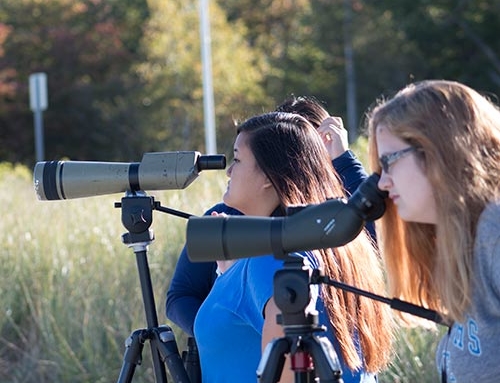Erick Schadler ’18 raises awareness through scientific research
By Emma Deans
Summer in Maine means pleasant days by the lake, scenic strolls through the woods, and evening bonfires with friends. It’s a time when tourists and residents alike seek to spend as much time as possible outside. It’s also a time of year when public health concerns rise about the creeping, crawling arachnids you sometimes feel moving up your leg or across your arm: ticks.
Enter Erick Schadler ’18, a biology major from Raymond, Maine. Erick pursued a summer research project to compare the abundance of black-legged ticks (Ixodes scapularis) by sex and age. He also investigated the infection rates of the bacteria that is the causative agent of Lyme disease (Borrelia burgdorferi) and of the bacteria that is the causative agent of anaplasmosis (Anaplasma phagocytophilum). Erick obtained financial support for this project through the Maine Space Grant Consortium, an affiliate that funds research of interest to NASA through the congressionally established National Space Grant College and Fellowship Program.
Erick focused his study on a section of brush along power lines in Raymond. He constructed a flag using a towel and a wooden stick, which he dragged across the ground as he walked 30 meters between 2-5 p.m. on three sunny and partly cloudy days (68-75 degrees Fahrenheit), spaced five days apart. The results were stunning. By simply dragging the small flag along a short stretch of brush, Erick collected 53 black-legged ticks, also known as deer ticks. “About half landed on the flag, half on me,” he explained.
After collecting the specimens, he used tweezers to remove them from the towel and placed them in 70 percent ethanol to preserve for testing in the genetics lab at Saint Joseph’s College.
Wearing a white lab coat and purple gloves, he chopped up the ticks and implemented methods of DNA extraction, DNA amplification by Polymerase Chain Reaction (PCR), and gel electrophoresis to determine if the 24 adult females, 21 adult males, and eight nymphs contained either of the two bacteria. He discovered that 79.2 percent of ticks carried the causative agent of Lyme disease, 30.2 percent of the ticks carried the causative agent of anaplasmosis, and 24.5 percent carried both causative agents. Maine Medical Center Research Institute provided Erick with controls for determining these rates and Erick received guidance for the entire project from his advisor Dr. Lucas Bernacki, professor of sciences at Saint Joseph’s College.
While Erick knew he would be exposed to several ticks, he didn’t think he would find so many. “The abundance of Ixodes scapularis was the most surprising aspect,” he said. Erick has continued his research this fall but switched from studying deer ticks to dog ticks in Raymond. He said that having the opportunity to conduct independent research at Saint Joseph’s College has been valuable and “has opened a lot of doors for me.” He is most interested in the intersection of science and healthcare. “The genetic testing procedure is used at all kinds of labs. It will be good for employers to see that I have this experience,” he said.
The Biology Curriculum covers principles of biology and chemistry, calculus, genetics, cellular biology, and biochemistry. Students can also minor in Biology or major in other related programs, including Medical Biology.
Photo caption: Erick Schadler ’18 constructed a flag using a towel and a wooden stick to collect ticks this summer for his research project. He discovered that 79.2 percent of the ticks he collected carried the causative agent of Lyme disease, 30.2 percent of the ticks carried the causative agent of anaplasmosis, and 24.5 percent carried both causative agents. Photo: Emma Deans.




